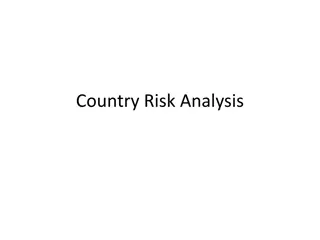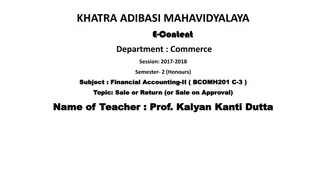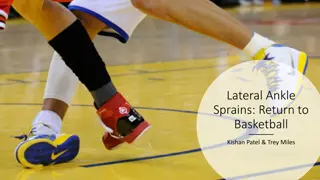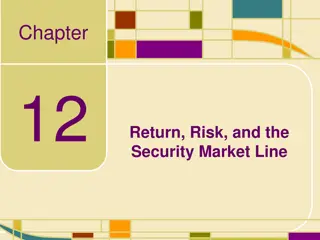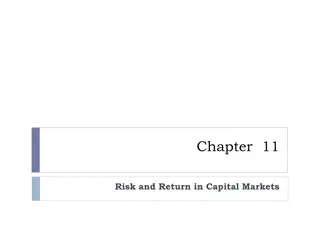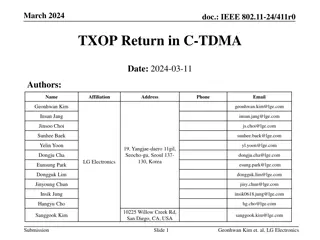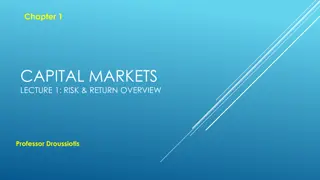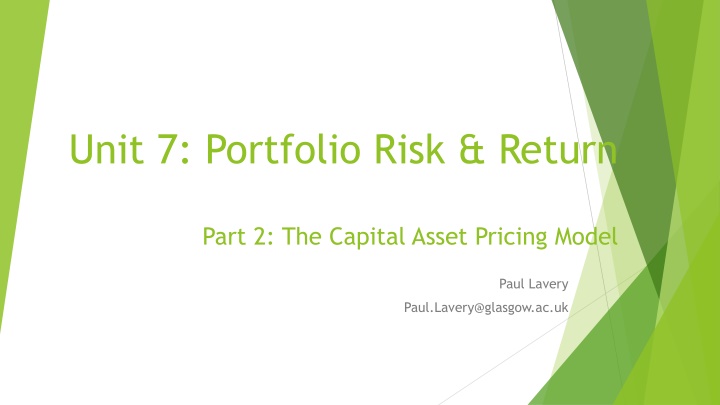
Portfolio Risk and Return with the Capital Asset Pricing Model
Explore the concepts of portfolio risk and return, Markowitz portfolio theory, efficient frontiers, and diversification in the context of the Capital Asset Pricing Model (CAPM). Learn how adding securities to a portfolio can reduce risk, the impact of correlation coefficients, the principles of portfolio construction, and the introduction of the risk-free asset to enhance investment strategies through the Capital Market Line (CML).
Download Presentation

Please find below an Image/Link to download the presentation.
The content on the website is provided AS IS for your information and personal use only. It may not be sold, licensed, or shared on other websites without obtaining consent from the author. If you encounter any issues during the download, it is possible that the publisher has removed the file from their server.
You are allowed to download the files provided on this website for personal or commercial use, subject to the condition that they are used lawfully. All files are the property of their respective owners.
The content on the website is provided AS IS for your information and personal use only. It may not be sold, licensed, or shared on other websites without obtaining consent from the author.
E N D
Presentation Transcript
Unit 7: Portfolio Risk & Return Part 2: The Capital Asset Pricing Model Paul Lavery Paul.Lavery@glasgow.ac.uk
Overview of the unit Measuring risk and return Markowitz portfolio theory, efficient frontiers and diversification The capital asset pricing model (CAPM)
Recap from last week: We can reduce risk (variance, standard deviation) by adding more securities to our portfolio Combining stocks into portfolios can reduce standard deviation, below the level obtained from a simple weighted average calculation Correlation coefficients make this possible In particular, securities which are negatively correlated helps reduce risk The various weighted combinations of stocks that create these standard deviations constitute the set of efficient portfolios
Recap from last week: Harry Markowitz (1952) developed the practice of diversification and the basic principles of portfolio construction. Combining stocks into portfolios can reduce standard deviation below simple weighted-average calculation As we add more securities to our portfolio, the idiosyncratic (firm-specific risk) is diversified away. Market risk (beta) is not. Correlation coefficients make this possible Various weighted combinations of stocks that create specific standard deviations constitute set of efficient portfolios Maximum reduction in risk is possible if the correlation coefficient is 1. By changing the proportion of funds invested in stocks, we can change the risk-return characteristics of a portfolio.
Efficient portfolio of two assets Two firms, where ? = 0.5 Firm A (asset 1): ?(?)?= 10%,??= 16.0% Firm B (asset 2): ?(?)?= 20%,??= 28.0%
Efficient portfolio of two assets Two firms, where ? = 1.0 Firm A: ?(?)?= 10%,??= 16.0% Firm B: ?(?)?= 20%,??= 28.0%
Introducing the risk free asset: The capital market line A new possibility opens up when we introduce the risk-free asset, such as a government bonds, whose risk we assume to be zero This opens up new possibilities to an investor They can invest in a risky portfolio and a risk-free asset They can now borrow at the risk free rate and invest more than they had to begin with This linear relationship is shown through the Capital Market Line (CML)
Introducing the risk free asset: The capital market line Firm B Firm A
Introducing the risk free asset: The capital market line The introduction of this risk-free asset lets an investor borrow/lend and invest more than they initially had (borrow) or invest all in a riskless asset (lend) At the left most point of the CML, we invest all in the risk-free asset At the right most point, we invest all in a risky asset When an investor can borrow or lend at the risk free rate, their investment opportunity set is expanded They can do more (and in microeconomic terms of utility, they can reach a higher indifference curve) The investor s choice depends on their level of risk The introduction of the risk-free rate therefore yields portfolios which are superior to those on the efficient frontier, for the same investor The CML is therefore superior to the efficient frontier
The CAPM The CAPM then moves forward from the CML by introducing a market portfolio The CAPM shows that equilibrium rates of return are a function of their covariance with the market ie it describes the relationship between assets risk and return, where risk is measured as the market risk (aka systematic risk, which cannot be diversified away)
Relationship between risk & return: the security market line
The CAPM The CAPM tells us that the expected return on an individual asset is given as: So under the CAPM, we are only rewarded for holding more market risk (systematic risk, or beta), but not idiosyncratic risk which can be diversified away
Recall: beta Beta ??? ?? ??= 2 ??? covariance with market ?? 2 variance of market is used as a standardised measure of market risk Firms with higher (lower) systematic risk than average will have beta greater (less) than 1 The risk-free asset has a beta of zero Interpretation If > 1 security is more exposed to systematic risk than market If < 1 security is less exposed to systematic risk than market
CML vs SML CML measure of risk is total risk (variance or standard deviation) SML measure of risk is systematic risk (beta) Only efficient portfolios will plot on the CML, but as the SML uses systematic risk (for which we are rewarded as we cannot diversify it away), all properly priced portfolios will plot on the SML A low-beta stock is not necessarily a low-total risk stock Eg a tech company developing an unproven drug may be speculative with potentially high returns It could have a low beta, but high total risk if the success depends on firm-specific factors
Regression analysis to estimate beta Obtain the historical time series of return (??) on the stock of interest ? Obtain the historical time series of ?? asset (e.g. t-bills) Take the difference between the two, and you ll end up with a historical time series of risk premium of stock ?, which is ?? ?? Obtain the historical time series of the market return ?? Take the difference between ?? and ??, and you ll end up with a historical time series of market risk premium, which ?? ?? Regress ?? ?? on ?? ?? to get the beta
Empirical studies of the CAPM Fama and McBeth(1973) Average return on a portfolio of stocks was positively related to the beta of the portfolio Fama and French (1992, 1993) Relationship between average returns and beta is weak Carhart (1997) Past performance results in higher returns in the near future (ie there is momentum in the market) inconsistent with the CAPM Ang et al. (2009) Stocks with greater sensitivity to market volatility have lower returns with control firms that have the same level of systematic risk
Empirical studies of the CAPM Other studies observe additional variables that affect stock returns: Size (Banz(1981)). E/P ratio (Basu(1983)) Leverage (Bhandari(1988)) See Fama (1991) for a review. Fama and French (1992) Insignificant risk premium on beta Size and Book-to-Market ratio explain most of the variation in stock returns Negative relationship between size and return Positive relationship between B/M and return
Measures of portfolio performance Sharpe Ratio Risk-adjusted performance measure which shows the excess return per unit of risk Accounts for both systematic and unsystematic risk The slope of the CML is the sharpe ratio for any portfolio along the CML Treynor Ratio Shows the excess return per unit of systematic risk
Measures of portfolio performance Jensen s alpha This shows the percentage return above that of a portfolio with the same beta of the portfolio that is on the SML Shows a portfolio s expected excess return over its theoretical expected return Jensen s alpha = (a) = r(a) [rf + (r(mkt) rf)]



